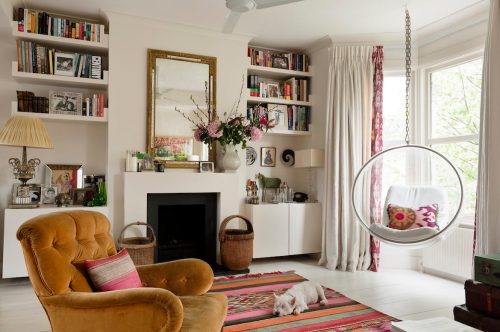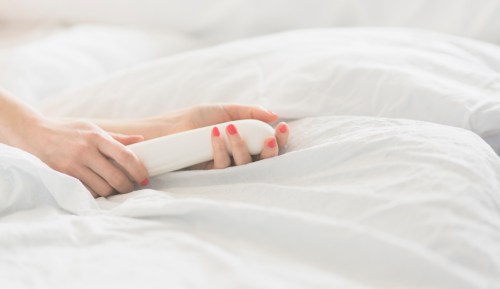Our editors independently select these products. Making a purchase through our links may earn Well+Good a commission
When my roommates and I moved into our apartment last summer, we embarked upon a thrifty journey to really make it feel like home. As cost-conscious 23-year-olds, that meant hitting up Ikea and Home Goods for cute, budget finds and scrounging for good secondhand deals on lightly used furniture. We found the perfect dining table and chair set for $40 on CraigsList. And we bid farewell to our offensively uncomfortable Ikea futon and got a gorgeous red-orange West Elm couch from AptDeco.
Experts in This Article
Maeve Richmond is an organization coach and the founder of Maeve’s Method. Her passion is helping people feel happier in their homes. She uses her people and creative skills, along her abilities as an energy healer and intuitive, to educate and empower her clients.
Reham Fagiri is the co-founder and CEO of AptDeco, a New York City-based online marketplace for buying and selling used furniture.
Not only did secondhand shopping help us save money, but it also meant we were helping to cut down on waste. Reham Fagiri, co-founder of AptDeco, a New York City-based online marketplace for buying and selling quality preowned furniture, says that’s the beauty in purchasing used furniture.
“Tons and tons of furniture end up in landfill every year,” says Fagiri. “As responsible citizens of this earth, I think it’s so important for people to think about reusing and not throwing furniture. Furniture actually has a very long shelf life if it’s good quality. Also, you can actually get really great products for a much cheaper price.”
Secondhand furniture shopping is having a moment. As Americans shift their thinking about sustainable living, the stigma attached to buying used furniture (or grabbing it off the sidewalk) is fading away. Instagram accounts like Reuse American NY and Stooping NYC are booming with people on the hunt for unique, affordable (or free) finds. YouTube Vloggers like The Sorry Girls and Lone Fox show the amazing ways you can transform used pieces. Having a piece that’s been previously loved makes it that much better.
What to look for when buying used furniture
When buying used furniture, Fagiri says you first want to learn about the piece’s backstory. If it’s a recent purchase (or something still available from the original retailer), you should know where it’s from so you can look it up; aim to get at least a 50-percent discount. If it’s vintage and in decent condition, you may actually end up paying more than it was originally worth.
“It’s important to understand where the piece came from,” she says. “You want to also ask the seller why they’re selling it. I think it’s important to understand that backstory. Is it comfortable? Are they selling you this because they’re moving? Or is there an issue with it?” Additionally, you should ask the seller about potential blemishes, odors, and bed bugs.
You should also consider how much work you’re willing to do. AptDeco is great because the pieces are vetted to ensure any wear and tear is minimal and manageable. But a raggedy table on Facebook Marketplace could turn into the piece of your dreams with a thorough sanding and a few coats of paint. Set your limits to help guide your shopping process.
If you haven’t yet jumped on the sustainable furniture train, while a used table that you can easily attack with a Clorox wipe may sound reasonable, the first thing that comes to mind when thinking of a used couch is probably “Ew.” I hear ya—that aforementioned Ikea futon was used and I refused to sit on it for the first few months we had it. Because it was so soft and squishy, I couldn’t help but think of all the germs living their best lives deep inside of it.
But Karen Hoffmann, RN, immediate past president of the Association for Professionals in Infection Control and Epidemiology (APIC), explains that soft surfaces are actually really bad at holding onto bacteria and viruses. In reference to the virus that causes COVID-19, Hoffmann says it lives longer on hard surfaces. “The more coarse the surface the quicker it is to die,” she says. And generally, germs last longer on non-porous surfaces like stainless steel and plastics.
How to clean used furniture properly
Maeve Richmond, organizational and cleaning expert behind Maeve’s Method, (who just got a gorgeous used blue-velvet armchair!) explains that you should still clean any and all used items you bring into your home. For an upholstered item, you’ll want to know what type of fabric you’re working with.
“Even on a used piece, improper fabric cleaning can cause damage, and you want to preserve the piece,” she says. “If the fabric is manmade—like a polyester, microfiber or olefin—you are in good shape. These are super durable and can take any kind of cleaning care, including chemical upholstery cleaners. But cottons, linens, and true velvets can be fragile and need gentle care.”
Her go-to for furniture cleaning is simply baking soda and white vinegar, which is gentle enough to use on fragile fabrics. Mix 1 tablespoon of baking soda with a half cup of vinegar and stir.
“You can then apply the mixture with a clean, cotton cloth or spritz with a spray bottle,” she says. “Gently moisten the fabric—never soak—and always begin on a test spot. And if you can, allow the piece to dry outdoors, or with the windows open, to add a touch of fresh air.”
When it comes to lifting stains, she says to let the vinegar-baking soda mixture sit for up to 30 minutes. “Blot the stain with the cloth, making gentle ‘up and away’ motions as you work,” she says. “Rinse and repeat as many times as it takes to lift the stain out.” Foor deep-set stains, ad a touch of clear dish soap to the mixture. “The soap will help to break down oils and organics, and do circular ‘up and away’ motions with an old toothbrush, as the bristles will help to loosen locked-in stains and bring them to the surface,” she says.
For a professional-level clean, consider investing in a vac like the Bissell Multi-Purpose Portable Carpet and Upholstery Cleaner ($110). “These machines shoot cleaning agent into fabric with water and immediately pull it back out again,” says Richmond. “They are a must-have for avid secondhand furniture aficionados as they are the quickest and most efficient way of cleaning someone else’s used fabric goods.”
If you’re concerned about the energy a used piece could bring into your home, Richmond recommends doing a sage smudge.
“Sage is a natural element known to clear energy from objects. I never bring anything used into my home without first doing a smudge, as it clears away the previous owner’s energy,” she says. “Simply light a stick or leaf of dried sage (yes, you can grab it from your cupboard), blow out the flame, then let the remaining smoke waft up and into the air. Wave the smoke around the edges of the furniture, making sure to hit corners and crevices. If you can, set an intention as you smudge. I like to say thank you to the previous owner—whomever they may be—then say hello to the piece as I welcome it into my home. It’s a surefire way of making sure that you begin the journey with your new secondhand piece on the right foot.”
Sign up for the Well+Good SHOP Newsletter
Get exclusive deals on wellness, beauty, fitness, and food products that have been hand-picked by our editors.
Got it, you've been added to our email list.










